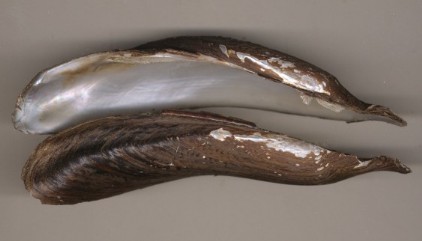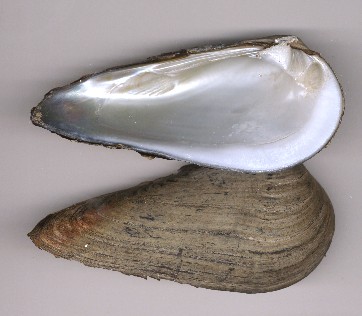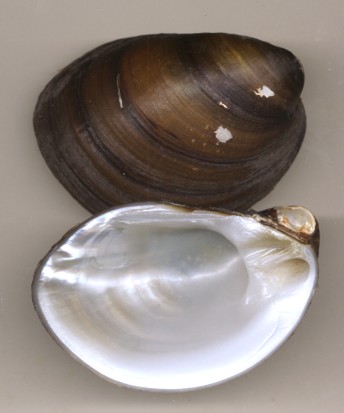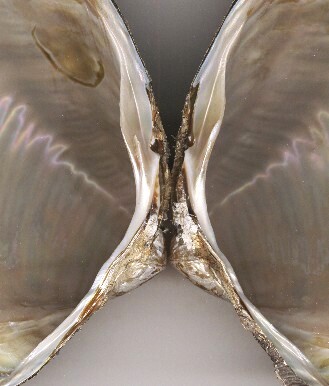|
||||||||||||||||||||||||||||||||||||||||||||||||||||||||||||||||||||||||||||||||||||||||
Freshwater Molluscan Shells / Asian pearly mussels
World Unionaceans
[Africa] [Asia] [Australia] [Europe] [South America]
China and Southeast Asia are home to a variety of unionaceans, second only to east and central North America. Liu Yueyin (1979) covers 38 unionacean species from Chinese territory, including several large thick-shelled species. Three illustrations from that source appear below. Preston (1915)describes 60 for the Indian subcontinent, and Wolfgang Fischer's web page at http://ipp.boku.ac.at/private/wf/Bivalvia_India/Bivalvia_Ganga_River.html lists 15 species in three genera native to the Ganges. Brandt (1974) covers 30 species and 17 additional subspecies in Thailand. Finally, Zhadin (1952) lists 23 for the area of the former USSR, of which 18, including three margaritiferidae, have ranges in the Soviet far east or Transcaucusus.
Family Unionidae
Lamellidens marginalis (Lamarck, 1819)
and hinge teeth. Preston, 1915 lists four
varieties and 11 subspecies of L. marginalis,
and seven additional Lamellidens species for
the Indian subcontinent.
Unio douglasiae biwae Kobelt, 1879. Japan.
The slightly more elongate U. d. taiwanicus
(Pilsbry, 1921) occurs in Taiwan.Inversidens reinianus Kobelt. Japan I. reinianus hinge teeth
Lanceolaria oxyrhyncha
v. Martens. Japan.
Lanceolaria eucylindrica Lin. FuJian Province, China.
Lanceolaria gladiola
(Heude, 1874). China,
and detail of hinge teeth.
Liu Yueyin lists one
additional Lanceolaria
species for China.
Hyriopsis cumingii (Lea, 1852) (1 Chinese Hyriopsis species, several additional in Southeast
Asia, below). This large flat mussel is widely cultured for freshwater and blister pearls cultured in
China. The Japanese Hyriopsis schlegelii (von Martens, 1861) lacks the ridges and sculpture, and is
similarly used for pearl culture in Japan.
Assymetrical shell development in freshwater bivalves
The characteristic of assymetrical or torted shell development appears more than once in Asian unionaceans, but nowhere else, outside of the very few sessile or cemented species. Of non-cemented marine bivalves, only the scallops, and the clam Macoma nasuta come to mind.
There are two or three species in the genus Arconaia (http://bama.ua.edu/~musselp/m/mom/archive/2006/index.html), and at least one in Lanceolaria with tortion that can be either sinistral or dextral . It is interesting to note that of the one pair of Arconaia specimens I was able to examine closely, the hinge teeth are not reversed as to left and right along with the tortion of the shell. In the genus Cuneopsis, Cuneopsis pisciculus alone shows well-developed tortion. In this instance, all specimens I could find images of were torted in the same direction -- as the shell extends posteriorly, it bends to the left while twisting to the right.Cuneopsis capitata and the Lamprotula species, Lamprotula tortuosa (see below) are also subtly assymetrical.

Arconaia lanceolata (Lea) and hinge teeth showing pseudocardinals. The lateral teeth extend over half the length of the shell and can be seen on the upper left of the left-hand image.
Cuneopsis pisciculus (Heude, 1874) (There are six Chinese
Cuneopsis species listed on
http://bama.ua.edu/~musselp/proj/grano_salis/unionidae.html
Lanceolaria triformis (Heude)
Dorsal and ventral views.
Poyang Lake, Jiangxi Province,
China. This species is also found
in both left and right distorted forms.

Cuneopsis capitata
(Heude). Poyang Lake,
Jiangxi Province, China,
with details of hinge teeth
and finely denticled surface
texture.The shell is also
weakly torted, in the same
sense as C. pisciculus above.
The heavy Lamprotulas are comparable to the many thick-shelled North American species. Liu Yueyin included 14 Lamprotula from Chinese territory, and the more comprehensive listing at http://bama.ua.edu/~musselp/proj/grano_salis/unionidae.html lists 26 species.
Lamprotula leai
(Griffith and Pidgeon,
1834) China.
Approximately natural
size. Hinge teeth below.
Chinese name,

L. tortuosa (Lea, 1865). besides being subtly torted,
this is one of the thickest and most inflated of the Lamprotulas.
Lamprotula caveata
(Heude, 1877) China.
Above, approximately natural
size, and hinge teeth,
left, x 2. Note thick shell,
large pseudocardinals,
and deep beak cavity in
both this and L. tortuosa
above. Chinese name
Lamprotula rochechourti
(Heude)Lamprotula cornuum-lunae (Heude) FuJian province,
China. Slightly magnified. Chinese nameLamprotula polysticta
(Heude)
Acuticosta chinensis (Lea) FuJian province, China, (Liu Yueyin lists 2 Chinese
Acuticosta species). Slightly magnified.
Schistodesmus spinosus Simpson. FuJian Province,
China, slightly magnified.
Schistodesmus lampreyanus (Baird & Adams, 1867). FuJian
Province, China, slightly magnified.
Three Solenaias from Poyang Lake, Jianxi Province. Top; Solenaia trianglularis (Heude, 1877),
Middle, S. carinata (Heude, 1877), and bottom, S. oleivora (Heude). All are thin shelled and lack any
trace of hinge teeth. Large shells shown somewhat reduced in size.
Open end of Solenaia carinata. The other
two species are completely enclosed by
their shells. I have no information to post
about the life station and habits of this
species.
Anodonta (Sinanodonta) woodiana
(Lea, 1831).
Species is invading worldwide with
Tilapia fish culture. This specimen
came from the Dominican Republic.
Right valve (on left) backlit with
incandescent light toshow rays.
They are intense blue green in color.
Liu Yueyin (1979) lists four subspecies
within the territory of China.
Left;
Cristaria herculea (Middendorf,
1847) East Asia. Huge shell
displayed at about 1/4 natural size
(25 dpi scan).
The equally large Cristaria
plicata (Leach), right, is more
strongly alate.

Lepidodesma languilati (Heude), Lake Poyang, Jianxi Province, China. Hinge teeth are unusual in showing well-
developed laterals but almost non-existant pseudocardinals. Also imaged is the concentrically ribbed umbonal area.
Southeast Asia
Brandt (1974) lists the following genera and number of species for the territory of Thailand:
Pseudodon 5 species + 6 additional subspecies
Pislbryconcha 2 species + 2 additional subspecies
Hyriopsis 2 subgenera with 4 species
Chamberlainia 1 species
Cristaria 1 species
Unionetta 1 species
Scabies 3 species
Harmandia 1 species
Indonaia 3 species
Ensidens 1 species + 1 additional subspecies
Uniandra 2 species + 2 additional subspecies
Physunio 6 species
Trapezoideus 1 species + 2 additional subspecies
Modellnaia 1 species.The black and white images below are modified from Brandt (1974)
Pilsbryconcha exilis Lea 1839
Vietnam.Pseudodon mouhoti Lea, 1863
Vietnam.
Hyriopsis myersiana (Lea, 1856)
Hyriopsis bialatus Simpson, 1900The characteristic of being "alate" has evolved several times in unionacean mussels in Africa, Asia, South America, and North America. In members of the unionidae, the "wings" are extensions of shelly material above the ligament, and connect the two valves at a sharp fold. The composite shelly material is elastic and semi-flexible when wet, and like the ligament, tensioned against the adductor muscles so as to open the shell when the muscles realax. The wings are most well-developed in young individuals, and tend to become broken and frazzled as the animal matures. They are also much more brittle when dry. For members of the family unionidae, any attempt to divide the shells causes them to crack unevenly, in a manner analogous to a chicken wishbone. Species that are alate tend to be thin-shelled and relatively flat, but there are many thin-shelled species that are not. The function is unknown, but may be to protect the ligament, alter the flow of water over the siphon, or protect the siphon as the animal pulls itself forward through the substrate. Please see images from North American species at http://mkohl.net/Unioninae.html (this site).
Scabies crispata (Gould, 1843) North Thailand. slightly enlarged. Ensidens ingallsianus ingallsianus (Lea, 1852)
Uniandra contradens rusticoides (Lea, 1856)
Physunio superbus (Lea, 1843)
Trapezoideus exolescens pallegoixi (Sowerby, 1867)